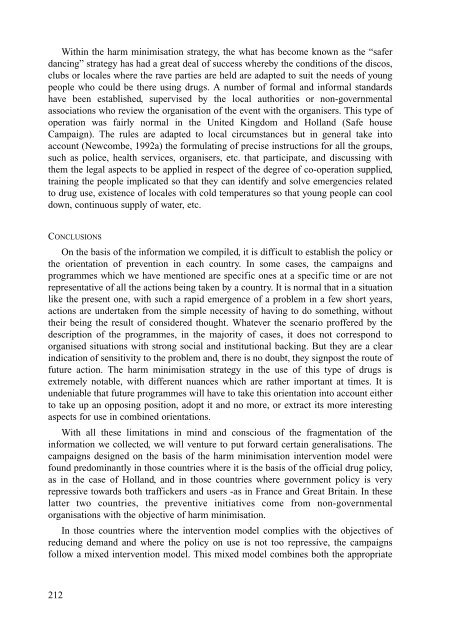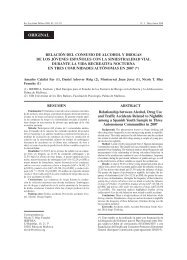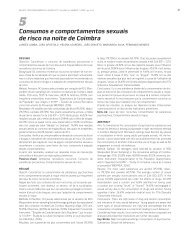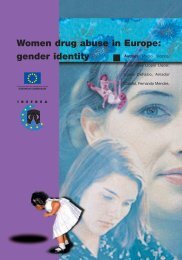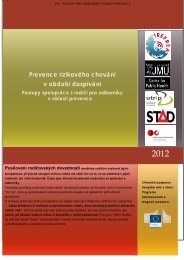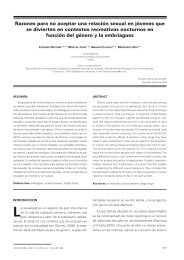Characteristics and social representation of ecstasy in Europe - Irefrea
Characteristics and social representation of ecstasy in Europe - Irefrea
Characteristics and social representation of ecstasy in Europe - Irefrea
You also want an ePaper? Increase the reach of your titles
YUMPU automatically turns print PDFs into web optimized ePapers that Google loves.
With<strong>in</strong> the harm m<strong>in</strong>imisation strategy, the what has become known as the “saferdanc<strong>in</strong>g” strategy has had a great deal <strong>of</strong> success whereby the conditions <strong>of</strong> the discos,clubs or locales where the rave parties are held are adapted to suit the needs <strong>of</strong> youngpeople who could be there us<strong>in</strong>g drugs. A number <strong>of</strong> formal <strong>and</strong> <strong>in</strong>formal st<strong>and</strong>ardshave been established, supervised by the local authorities or non-governmentalassociations who review the organisation <strong>of</strong> the event with the organisers. This type <strong>of</strong>operation was fairly normal <strong>in</strong> the United K<strong>in</strong>gdom <strong>and</strong> Holl<strong>and</strong> (Safe houseCampaign). The rules are adapted to local circumstances but <strong>in</strong> general take <strong>in</strong>toaccount (Newcombe, 1992a) the formulat<strong>in</strong>g <strong>of</strong> precise <strong>in</strong>structions for all the groups,such as police, health services, organisers, etc. that participate, <strong>and</strong> discuss<strong>in</strong>g withthem the legal aspects to be applied <strong>in</strong> respect <strong>of</strong> the degree <strong>of</strong> co-operation supplied,tra<strong>in</strong><strong>in</strong>g the people implicated so that they can identify <strong>and</strong> solve emergencies relatedto drug use, existence <strong>of</strong> locales with cold temperatures so that young people can cooldown, cont<strong>in</strong>uous supply <strong>of</strong> water, etc.CONCLUSIONSOn the basis <strong>of</strong> the <strong>in</strong>formation we compiled, it is difficult to establish the policy orthe orientation <strong>of</strong> prevention <strong>in</strong> each country. In some cases, the campaigns <strong>and</strong>programmes which we have mentioned are specific ones at a specific time or are notrepresentative <strong>of</strong> all the actions be<strong>in</strong>g taken by a country. It is normal that <strong>in</strong> a situationlike the present one, with such a rapid emergence <strong>of</strong> a problem <strong>in</strong> a few short years,actions are undertaken from the simple necessity <strong>of</strong> hav<strong>in</strong>g to do someth<strong>in</strong>g, withouttheir be<strong>in</strong>g the result <strong>of</strong> considered thought. Whatever the scenario pr<strong>of</strong>fered by thedescription <strong>of</strong> the programmes, <strong>in</strong> the majority <strong>of</strong> cases, it does not correspond toorganised situations with strong <strong>social</strong> <strong>and</strong> <strong>in</strong>stitutional back<strong>in</strong>g. But they are a clear<strong>in</strong>dication <strong>of</strong> sensitivity to the problem <strong>and</strong>, there is no doubt, they signpost the route <strong>of</strong>future action. The harm m<strong>in</strong>imisation strategy <strong>in</strong> the use <strong>of</strong> this type <strong>of</strong> drugs isextremely notable, with different nuances which are rather important at times. It isundeniable that future programmes will have to take this orientation <strong>in</strong>to account eitherto take up an oppos<strong>in</strong>g position, adopt it <strong>and</strong> no more, or extract its more <strong>in</strong>terest<strong>in</strong>gaspects for use <strong>in</strong> comb<strong>in</strong>ed orientations.With all these limitations <strong>in</strong> m<strong>in</strong>d <strong>and</strong> conscious <strong>of</strong> the fragmentation <strong>of</strong> the<strong>in</strong>formation we collected, we will venture to put forward certa<strong>in</strong> generalisations. Thecampaigns designed on the basis <strong>of</strong> the harm m<strong>in</strong>imisation <strong>in</strong>tervention model werefound predom<strong>in</strong>antly <strong>in</strong> those countries where it is the basis <strong>of</strong> the <strong>of</strong>ficial drug policy,as <strong>in</strong> the case <strong>of</strong> Holl<strong>and</strong>, <strong>and</strong> <strong>in</strong> those countries where government policy is veryrepressive towards both traffickers <strong>and</strong> users -as <strong>in</strong> France <strong>and</strong> Great Brita<strong>in</strong>. In theselatter two countries, the preventive <strong>in</strong>itiatives come from non-governmentalorganisations with the objective <strong>of</strong> harm m<strong>in</strong>imisation.In those countries where the <strong>in</strong>tervention model complies with the objectives <strong>of</strong>reduc<strong>in</strong>g dem<strong>and</strong> <strong>and</strong> where the policy on use is not too repressive, the campaignsfollow a mixed <strong>in</strong>tervention model. This mixed model comb<strong>in</strong>es both the appropriate212


